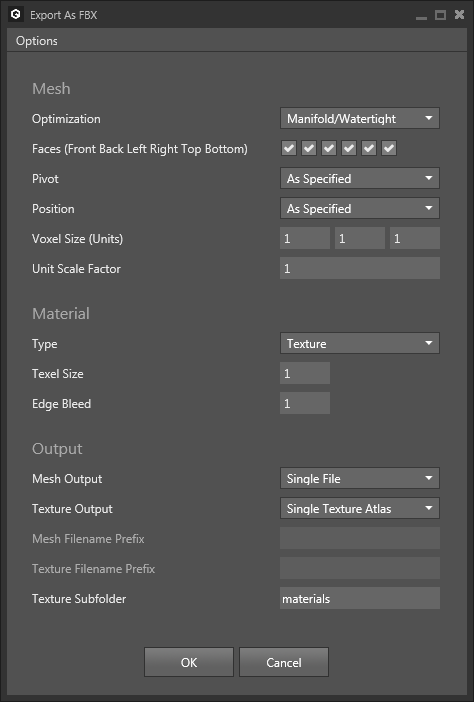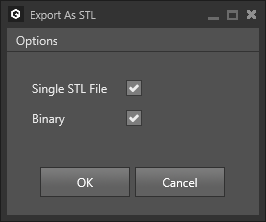Export Mesh
Export your voxel models as meshes to use them with third party tools like game devlopment engines.
Table of contents
Supported File Types
Qubicle 3.0 supports 4 different mesh file formats. We recommend using FBX, because it is the most powerful file format and a bit faster to create.
| File Type | Description |
|---|---|
FBX | Exchange format developed by Autodesk. Qubicle supports the binary variant. |
Collada DAE | Human readable XML file format. |
Wavefront OBJ | Supported by almost all 3D tools. Does not support vertex colors or pivots. |
STL | Prefered by 3D printers due to its strict rules. |
How to Export a Mesh
Before exporting your model:
- ensure that your matrices don’t have any hollows. This might be counter-intuitive but hollows increase the poly count. To remove hollows use Fill Hollows.
- If you want to export multiple Matrices as a single object you don’t need to combine them with Boolean Union, instead use Compounds. A Compound is exported the same way as a single Matrix. Select the matrices and Create a Compound.
- If you need to export a selection of your model again and again Compounds are very useful, too. Create a Compound of that selection and enter the new Compound before export. Only child objects of the active node are exported.
- If you want to export everything either select all objects or deselect. If you only want to export a part of your model select it.
Then, when you are ready to export:
- Choose
File > Export >FBXDAEOBJSTL - Adjust export settings
- Select the filename
Export Settings
FBX, OBJ, DAE

| Setting | Description |
|---|---|
Optimization | None: remove invisible lamina faces, no face merging. Non-Manifold: remove lamina faces, additional face merging (produces the lowest poly count but may lead to unwanted tiny dots when used in game engines). Manifold: remove lamina faces, additional face merging, watertight (requires more triangles than non-manifold meshes, but better for game engines). |
Faces | Remove unchecked voxel faces from the export. Useful when parts of your model, e.g. the bottom are not visible by the user. |
Pivot Position | (unavailable for OBJ) As Specified: use pivots manually set in your model. Centered: use object center as pivot. |
Position | As Specified: places the objects as specified in your model. World Origin: move objects to (0, 0, 0). |
Voxel Size (Units) | Specifies the size of a single voxel in units. Default is 1:1:1. Values are multiplied to all vertex positions and also the object’s position and pivot. |
Unit Scale Factor | (unavailable for OBJ) Tells the target tool how the default unit size should be scaled. E.g. a default unit in FBX is 1m. If you set it to 0.01 then a unit is 1cm. |
Type | Texture: store color information in a separate .png file. Affected by Optimization, Texel Size and Edge Bleed. When mesh optimization is disabled a texture is created with a single square for each unique color that is used in the model. |
Texel Size | Defines how many pixels are used for a voxel face on the texture. |
Edge Bleed | Adds an outline to texels of given size. Useful to avoid render interpolation issues. |
Mesh Output | Single File: store all objects in a single file. One File Per Object: create a separate file for each object. |
Texture Output | Single Texture Atlas: create a single texture file (atlas) for all objects. One File Per Object: create a separate texture for each object. |
Mesh Filename Prefix | Sets a prefix added to the filename of all exported mesh files. |
Texture Filename Prefix | Sets a prefix added to the filename of all exported texture files. |
Texture Subfolder | Sets a subfolder for the texture output relative to the export folder |
STL

| Setting | Description |
|---|---|
Single STL File | Check this setting to put all generated meshes into a single file. If you leave this option unckecked then a separate file will be created for each selected object. |
Binary | STL can be saved as a text file or in binary. Check this option to save the smaller binary variant. |